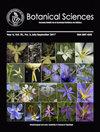Floral ecology of Puya ctenorhyncha (Bromeliaceae) an endemic plant of Bolivia
IF 0.7
4区 生物学
Q3 PLANT SCIENCES
引用次数: 0
Abstract
Background: The terrestrial bromeliad Puya ctenorhyncha is a near-threatened endemic species that grows between 2,500-4,050 m asl. Hypotheses: Hummingbirds are the most important visitors of this plant given its morphological and floral traits. Study site: The study was carried out along the “Death Road”, located in the Yungas montane cloud forest, La Paz, Bolivia. Methods: We monitored an average of 216 individuals monthly for two years (2018-2019). Besides we conducted direct observations of focal plants to quantify the visits of animals. Results: The reproductive season lasted from April to August in the first year and from May to June in the second. The mean nectar volume was 8.09 ± 1.59 μL per flower and its composition included fructose, glucose, and 86 % of water. With 341 hours of observations, we determined that Coeligena torquata (Trochilidae) is the main visitor and putative pollinator, followed by C. violifer. Males of both species were more frequent visitors than females. Coeligena torquatashowed the highest activity during the afternoon while C. violifer was more active in the morning. Conclusions: Floral phenology seems to be annual and unimodal. Although the main pollinators seem to be hummingbirds, the nectar concentration and composition is more similar to bromeliad species of other genera which are pollinated by bats or passerine birds. It is important to evaluate, in future studies, the dependence of both hummingbirds and their behavioural response towards the plant.玻利维亚特有植物 Puya ctenorhyncha(凤梨科)的花卉生态学
背景:陆生凤梨Puya ctenorhyncha是一种濒临灭绝的特有物种,生长在海拔2,500-4,050米之间。 假设:蜂鸟是凤梨科植物中最重要的鸟类:鉴于其形态和花朵特征,蜂鸟是该植物最重要的访客。 研究地点研究沿着位于玻利维亚拉巴斯永加斯山地云雾林的 "死亡之路 "进行。 研究方法我们平均每月监测 216 个个体,为期两年(2018-2019 年)。此外,我们还对重点植物进行了直接观察,以量化动物的访问情况。 结果:第一年的繁殖季节为 4 月至 8 月,第二年为 5 月至 6 月。每朵花的平均花蜜量为 8.09 ± 1.59 μL,其成分包括果糖、葡萄糖和 86% 的水。通过 341 个小时的观察,我们确定蝶形花科(Coeligena torquata)是主要的访客和授粉者,其次是蝶形花科(C. violifer)。这两个物种中的雄性都比雌性来得频繁。Coeligena torquatata在下午表现得最为活跃,而 C. violifer则在上午更为活跃。 结论花期似乎是一年一度的,而且是单模的。虽然主要授粉者似乎是蜂鸟,但其花蜜浓度和成分与其他属的凤梨科植物更为相似,后者由蝙蝠或飞禽授粉。在今后的研究中,对蜂鸟的依赖性及其对植物的行为反应进行评估非常重要。
本文章由计算机程序翻译,如有差异,请以英文原文为准。
求助全文
约1分钟内获得全文
求助全文
来源期刊

Botanical Sciences
Agricultural and Biological Sciences-Plant Science
CiteScore
1.90
自引率
21.40%
发文量
71
审稿时长
16 weeks
期刊介绍:
Botanical Sciences welcomes contributions that present original, previously unpublished results in Botany, including disciplines such as ecology and evolution, structure and function, systematics and taxonomy, in addition to other areas related to the study of plants. Research reviews are also accepted if they summarize recent advances in a subject, discipline, area, or developmental trend of botany; these should include an analytical, critical, and interpretative approach to a specific topic. Acceptance for reviews will be evaluated first by the Review Editor. Opinion Notes and Book Reviews are also published as long as a relevant contribution in the study of Botany is explained and supported.
 求助内容:
求助内容: 应助结果提醒方式:
应助结果提醒方式:


